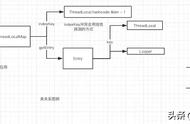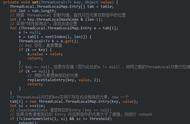ThreadLocal从名字上看好像是一个Thread,其实并不是,它是Therad的局部变量的维护类。作用是让变量私有化(为每个Thread提供变量的副本),以此来实现线程间变量的隔离。比如有一个变量count,在多线程并发时操作count 会出现线程安全问题。但是通过ThreadLocal count,就可以为每个线程创建只属于当前线程的count副本,各自操作各自的副本,不会影响到其他线程。我们先有个概念,具体还是看源码(JDK1.8)。

简单用法
publicstaticvoidmain(String[]args){
ThreadLocal<String>a=newThreadLocal<String>();
a.set("1");
a.set("2");
System.out.println(a.get());
}
//输出结果是2。貌似“1”被覆盖了。
先看一下set(T value)方法。
/**
*Setsthecurrentthread'scopyofthisthread-localvariable
*tothespecifiedvalue.Mostsubclasseswillhavenoneedto
*overridethismethod,relyingsolelyonthe{@link#initialValue}
*methodtosetthevaluesofthread-locals.
*
*@paramvaluethevaluetobestoredinthecurrentthread'scopyof
*thisthread-local.
*
*/
publicvoidset(Tvalue){
//当前线程
Threadt=Thread.currentThread();
//获取ThreadLocalMap
ThreadLocalMapmap=getMap(t);
//map为空就创建,不为空就set
if(map!=null)
map.set(this,value);
else
createMap(t,value);
}
//给t.threadLocals赋值成ThreadLocalMap实例。
voidcreateMap(Threadt,TfirstValue){
t.threadLocals=newThreadLocalMap(this,firstValue);
}
ThreadLocalMap(ThreadLocal<?>firstKey,ObjectfirstValue){
table=newEntry[INITIAL_CAPACITY];
inti=firstKey.threadLocalHashCode&(INITIAL_CAPACITY-1);
table[i]=newEntry(firstKey,firstValue);
size=1;
setThreshold(INITIAL_CAPACITY);
}
/**
*Settheresizethresholdtomaintainatworsta2/3loadfactor.
*/
privatevoidsetThreshold(intlen){
threshold=len*2/3;
}
/*当前线程对于的ThreadLocalMap实例,在ThreadL类中*/
ThreadLocal.ThreadLocalMapthreadLocals=null;
这段代码逻辑比较简单,主要看ThreadLocalMap,它是TreadLocal的内部类,虽然没有实现Map接口,但看它的几个主要属性:Entry[] table、size、threshold、INITIAL_CAPACITY,和java.util.HashMap极其类似。关于这些属性更详尽的解释可以看一下这篇深入讲解HashMap的工作原理 。class注释中也提到它是一个为存放本地线程值而定制的hash map。它的key就是ThreadLocal当前实例this,值就是set的参数值。既然是hash map,就有可能出现hash冲突的问题,再复习一下解决hash冲突的常见方法
- 再哈希法:如果hash出的index已经有值,就再hash,不行继续hash,直至找到空的index位置。
- **开放地址法:**如果hash出的index已经有值,通过算法在它前面或后面的若干位置寻找空位。
- 建立公共溢出区: 把冲突的hash值放到另外一块溢出区。
- 链式地址法: 把产生hash冲突的hash值以链表形式存储在index位置上。HashMap的解决方案。
ThreadLocalMap用的是开放地址方法,如果当前位置有值,就继续寻找下一个位置,注意table[len-1]的下一个位置是table[0],就像是一个环形数组,所以也叫闭散列法。如果一直都找不到空位置就会出现死循环,发生内存溢出。当然有扩容机制,一般不会找不到空位置的。
/**
*ThreadLocalMapisacustomizedhashmapsuitableonlyfor
*maintainingthreadlocalvalues.Nooperationsareexported
*outsideoftheThreadLocalclass.Theclassispackageprivateto
*allowdeclarationoffieldsinclassThread.Tohelpdealwith
*verylargeandlong-livedusages,thehashtableentriesuse
*WeakReferencesforkeys.However,sincereferencequeuesarenot
*used,staleentriesareguaranteedtoberemovedonlywhen
*thetablestartsrunningoutofspace.
*
*/
staticclassThreadLocalMap{
staticclassEntryextendsWeakReference<ThreadLocal<?>>{
/**ThevalueassociatedwiththisThreadLocal.*/
Objectvalue;
Entry(ThreadLocal<?>k,Objectv){
super(k);
value=v;
}
}
/**
*Thetable,resizedasnecessary.
*table.lengthMUSTalwaysbeapoweroftwo.
*table.length必须是2的幂次
*/
privateEntry[]table;
/**
*Thenumberofentriesinthetable.
*table实际已经存放#Entry的数量
*/
privateintsize=0;
/**
*Thenextsizevalueatwhichtoresize.
*table扩容的阈值,初始threshold=length*2/3,当size>threshold*3/4时就扩容
*/
privateintthreshold;
/**
*Theinitialcapacity--MUSTbeapoweroftwo.
*table的默认容量
*/
privatestaticfinalintINITIAL_CAPACITY=16;
/**
*Setthevalueassociatedwithkey.
*
*@paramkeythethreadlocalobject
*@paramvaluethevaluetobeset
*/
privatevoidset(ThreadLocal<?>key,Objectvalue){
Entry[]tab=table;
intlen=tab.length;
//计算key的角标index。就是用key的threadLocalHashCode&(len-1)等效于key.threadLocalHashCode%len
//只是&要比%效率高,它们之所以可以等效,因为len是2的n次幂。
//threadLocalHashCode并不影响读懂这块代码,放在后面详说
inti=key.threadLocalHashCode&(len-1);
//开放地址方法,循环tab
for(Entrye=tab[i];
e!=null;
e=tab[i=nextIndex(i,len)]){
ThreadLocal<?>k=e.get();
//key相同,更新value
if(k==key){
e.value=value;
return;
}
//key为空,说明ThreadLocal实例被回收了,用新key-value替代
if(k==null){
replaceStaleEntry(key,value,i);
return;
}
}
//table[i]=null新建一个Entity, size
tab[i]=newEntry(key,value);
intsz= size;
if(!cleanSomeSlots(i,sz)&&sz>=threshold)
rehash();
}
//整理table
privatevoidrehash(){
//删除table[]陈旧元素
expungeStaleEntries();
//size依然大于3/4threshold,扩容
if(size>=threshold-threshold/4)
resize();
}
/**
*Expungeallstaleentriesinthetable.
*删除table[]所有key==null的entity
*/
privatevoidexpungeStaleEntries(){
Entry[]tab=table;
intlen=tab.length;
for(intj=0;j<len;j ){
Entrye=tab[j];
if(e!=null&&e.get()==null)
expungeStaleEntry(j);
}
}
/**
*Doublethecapacityofthetable.
*扩容为原数组的2倍
*/
privatevoidresize(){
Entry[]oldTab=table;
intoldLen=oldTab.length;
intnewLen=oldLen*2;
//创建2倍容量的新数组
Entry[]newTab=newEntry[newLen];
intcount=0;
for(intj=0;j<oldLen; j){
Entrye=oldTab[j];
if(e!=null){
//如果线程的
ThreadLocal<?>k=e.get();
if(k==null){
e.value=null;//HelptheGC
}else{
//计算新数组index
inth=k.threadLocalHashCode&(newLen-1);
while(newTab[h]!=null)
h=nextIndex(h,newLen);
newTab[h]=e;
count ;
}
}
}
setThreshold(newLen);
size=count;
table=newTab;
}
//返回当前线程对应的ThreadLocalMap
ThreadLocalMapgetMap(Threadt){
returnt.threadLocals;
}
}
看了set方法,get方法就
/**
*Returnsthevalueinthecurrentthread'scopyofthis
*thread-localvariable.Ifthevariablehasnovalueforthe
*currentthread,itisfirstinitializedtothevaluereturned
*byaninvocationofthe{@link#initialValue}method.
*
*@returnthecurrentthread'svalueofthisthread-local
*/
publicTget(){
Threadt=Thread.currentThread();
ThreadLocalMapmap=getMap(t);
if(map!=null){
ThreadLocalMap.Entrye=map.getEntry(this);
if(e!=null){
@SuppressWarnings("unchecked")
Tresult=(T)e.value;
returnresult;
}
}
returnsetInitialValue();
}
/**
*Variantofset()toestablishinitialValue.Usedinstead
*ofset()incaseuserhasoverriddentheset()method.
*
*@returntheinitialvalue
*/
privateTsetInitialValue(){
Tvalue=initialValue();//null
Threadt=Thread.currentThread();
ThreadLocalMapmap=getMap(t);
if(map!=null)
map.set(this,value);
else
createMap(t,value);
returnvalue;
}
//默认值null
protectedTinitialValue(){
returnnull;
}
源码总结:
总体来讲,ThreadLocal源码比较好理解。ThreadLocalMap虽然在ThreadLocal中定义,但是被Thread.threadLocals引用。这样保证了一个Thread拥有独立的ThreadLocalMap,做到和其他线程隔离。而ThreadLocalMap的key就是ThreadLocal实例,value就是线程变量。
再看一下最开始的源码。
publicstaticvoidmain(String[]args){
ThreadLocal<String>a=newThreadLocal<String>();
a.set("1");
a.set("2");
System.out.println(a.get());
}
//输出结果是2。貌似“1”被覆盖了。
//确实是被覆盖了,Thread.threadLocals的key是a,值当然只能有一个,get到的值也是最后一个value
//单线程的内部实现类似这样
ThreadLocal<String>a=newThreadLocal<String>();
Mapmap=newHashMap();
map.put(a,"1");
map.put(a,"2");
System.out.println(map.get(a));
源码中的问题总结
- ThreadLocalMap的hash冲突问题
上文说到ThreadLocalMap解决hash冲突的方法是开放地址。但对threadLocalHashCode没有详细说明,下面补充说明一下它。
//计算数组下标
inti=key.threadLocalHashCode&(len-1);
privatefinalintthreadLocalHashCode=nextHashCode();
/**
*Thenexthashcodetobegivenout.Updatedatomically.Startsat
*zero.
*线程安全的原子类,发出下一个hashcode
*/
privatestaticAtomicIntegernextHashCode=newAtomicInteger();
/**
*getAndAdd(v)返回的结果是nextHashCode,但是nextHashCode =HASH_INCREMENT;
*/
privatestaticintnextHashCode(){
returnnextHashCode.getAndAdd(HASH_INCREMENT);
}
/**
*Thedifferencebetweensuccessivelygeneratedhashcodes-turns
*implicitsequentialthread-localIDsintonear-optimallyspread
*multiplicativehashvaluesforpower-of-two-sizedtables.
*自增量
*/
privatestaticfinalintHASH_INCREMENT=0x61c88647;
因为nextHashCode被static修饰,所以每次new ThreadLocal()都会自增HASH_INCREMENT,其值和斐波那契散列(Fibonacci)有关,主要目的是为了让哈希码能均匀的分布在2的n次方的数组里。这也是为什么table的容量是2的n次方的一个原因。
- 内存泄漏 & 弱引用 ThreadLocal使用不当可能会出现内存泄露,进而可能导致内存溢出**, 内存泄露:垃圾对象没有及时回收或无法回收,一般情况下是因为对象有错误的引用,导致内存浪费,这些垃圾越来越多可能会导致内存溢出,内存溢出:没有足够的内存提供申请者使用。 当然了,任何操作不当都会出现内存泄露或其他bug,我们这里只谈论ThreadLocal。 回顾Thread、ThreadLocal、ThreadLocalMap的关系。 Thread.threadLocals引用ThreadLocalMap,生命周期一致。ThreadLocal定义ThreadLocalMapThreadLocalMap#Entry弱引用ThreadLocal。我们通常说一个对象不被引用就会被gc回收,其实说的是强引用。但弱引用对象是,不管有没有被引用都会被垃圾回收。 当一个Thread执行完,被销毁后,Thread.threadLocals指向的ThreadLocalMap实例也会随之变为垃圾,当然它里面存放的Entity也会被回收。这时是不会发生内存泄漏的。 发生内存泄漏一般是在线程池,Thread生命周期比较长,threadLocals引用一直存在,当其存放的ThreadLocal被回收(弱引用生命周期比较短)后,它对应的Entity就成了key==null的实例,依然不会被回收。如果此Entity一直不被get()、set()、remove()它就一直不会被回收,也就发生了内存泄漏。通常在使用完ThreadLocal都会调用它的remove()。 补充:在ThreadLocal的get、set的时候,都会检查当前Entity的key是否为null,如果是null就把Entity释放掉,被垃圾回收。
它的应用场景主要有
- 线程安全,包裹线程不安全的工具类,比如java.text.SimpleDateFormat类,当然jdk1.8已经给出了对应的线程安全的类java.time.format.DateTimeFormatter
- 线程隔离,比如数据库连接管理、Session管理、mdc日志追踪等。
最近在与前端对接的接口中用到了ThreadLocal。大概流程是,前端在请求后端接口时在header带上toekn,拦截器通过token获取到用户信息,通过ThreadLocal保存。主要代码如下:
//接口请求时先走filter
publicbooleancheckUserLogin(Stringtoken){
UserDTOuser=getUserByToken(token);
ContextUtil.setUserId(user.getId());
}
publicclassContextUtil{
privatestaticThreadLocal<String>userIdHolder=newThreadLocal();
//存储userid
publicstaticvoidsetUserId(StringuserId){
userIdHolder.set(userId);
}
publicstaticStringgetUserId(){
return(String)userIdHolder.get();
}
}
//实际调用接口
voidinvokeInterface(){
StringuserId=ContextUtil.getUserId();
.....
}
每一次接口请求都是一个线程,在校验接口合法后把userid存入ThreadLocal,以备后续之用。
总结我们通过源码,对ThreadLocal的原理和应用作了深入讲解。当然本人能力一般,水平有限,难免有些谬误。还请各位多担待,欢迎指正。有反馈才有进步。
,














